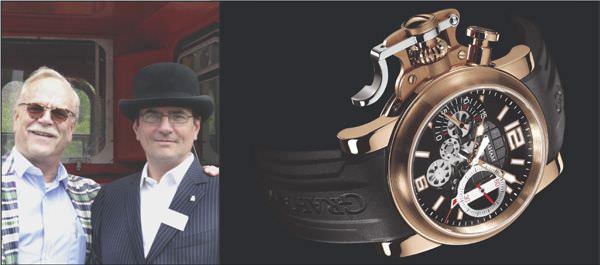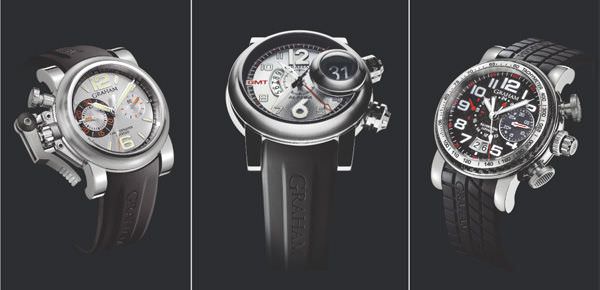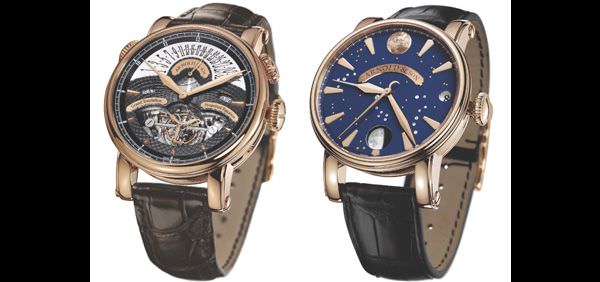As I managed to catch my breathe, I was charmingly greeted by Eric Loth, CEO of the British Masters and Max Imgrüth, Marketing Director, who both must have been British in a previous life – Eric Loth wearing an elegant British suit and bowler hat and Max Imgrüth sporting some rather psychedelic orange socks. The only thing that gave them away was the expresso in their hands instead of a steaming cup of tea with milk!
As we left Neuchâtel’s port into a lake that looked choppier than the English Channel, we were taken on a tour of the British Masters, Graham and Arnold, both past and present. The stories of these two gentlemen are quite remarkable. Both George Graham (1673-1751) and John Arnold (1736-1799) lived at a time when London was leading the world with horological developments.

Max Imgrüth and Eric Loth, CHRONOFIGHTER R.A.C. SKELETON
A short history lesson
George Graham was the first watchmaker to be accepted as a fellow of the Royal Society, the United Kingdom’s national academy for science. Graham revolutionized the world of watchmaking with inventions such as the dead-beat cylinder escapement, the first wall chronograph and the mercury pendulum, which were key discoveries in the research for a solution to measuring longitude at sea. Graham was so well respected that, on his death, he was buried in Westminster Abbey, one of the greatest honours for a subject of his or her Majesty (for the history buffs amongst you, the majority of Britain’s Kings and Queens have been buried at Westminster Abbey since the year 1065).
John Arnold obtained international acclaim for his detent escapement, his bi-metallic and helical balance springs and for inventing the world’s first pocket chronometer. He also succeeded in reproducing high-precision timepieces on an industrial scale, increasing his production from the usual 500 pieces in a lifetime to over 5,000. This feat resulted in him becoming one of four watchmakers to win the Longitude Act competition established by Queen Anne in 1714. As an aside: John Arnold and Louis-Abraham Breguet were good friends and both their sons worked as apprentices for the other. In 1808, nine years after John Arnold’s death, Breguet assembled his first functioning tourbillon on one of John Arnold’s marine chronometers and gave it to Arnold’s son as a tribute to his father.

CHRONOFIGHTER OVERSIZE RANGER, GRILLO, GRAND SILVERSTONE LUFFIELD
Today’s British Masters
As our boat left Lake Neuchâtel along a picturesque canal for Lake Morat, Eric Loth and Max Imgrüth shared how they had brought the British Masters back to life. Loth explained how the British connection had allowed him to be more daring with the design of the watches, something he wouldn’t have been able to do if he had been working on a Swiss brand. He wanted to take the heritage and do something modern. It was a risk; especially back in 1995 when there were very few non-Swiss brands on the market. “When we brought out Graham’s Swordfish collection at the Basel Fair, it was a catastrophe,” he remembers with a smile, “the markets ordered to be kind and the press published a few photos, but luckily the collectors were the ones who forced the retailers to buy.
“You either love it or hate it,” he continues, “We cannot go to the extreme without having a reaction of rejection. I can live with that.” The five investors in the company (one of whom is Mr. Asprey from the very famous British retailer Asprey London.) can obviously “live with it” too, as this year’s sales are predicted to triple from the year 2005.
It wasn’t until I got to handle the timepieces that I was really able to understand what this modern British style was. So as our boat moored to the small jetty of the Hotel Le Vieux Manoir for lunch – I was looking forward to seeing the watches up close. I certainly wasn’t disappointed - strong lines, bold colours and those famous crowns – this is a brand I would wear (if I was a man that is!). We saw the Chronofighter RAC (with a pusher that was inspired by a foot pedal in the toilet of a British public house!), the Black and Mortimer, the Chronofighter Oversize, the Grillo, the Grand Silverstone Luffield – they just kept coming - each collection more daring than the next.
Loth also presented the latest models from Arnold & Sons, going through the technical specifications on an overhead projector using his black umbrella as a pointer. We were shown the latest True Moon, an automatic timepiece that uses a world-first mechanism that keeps precise track of the true waxing and waning faces of the moon, and the latest King George tourbillon, a project which has been developed in collaboration with Christophe Claret. There is obviously no lack of energy in the British Masters’ team as design and technology are being researched and developed without restriction.

GRAND TOURBILLON PERPETUAL EQUATION, TRUE MOON
Future
As we returned to Neuchâtel in true British style on the top deck of a bright red London bus, I was eager to enquire whether there were any plans for a women’s collection – alas, the answer was ‘no’ (although women have been purchasing the more feminine colours from Graham’s Juices Collection). It’s too bad, maybe a British Masters women’s timepiece could help keep me on time as I run around the Swiss countryside trying to keep up with the latest industry developments!
Source: Europa Star October-November 2007 Magazine Issue




